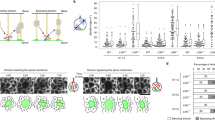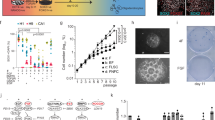Abstract
Neuroblasts arising in the adult forebrain that travel to the olfactory bulb use two modes of migration: tangentially, along the rostral migratory stream, and radially, in the core of the olfactory bulb where they start to ascend to the outer layers. Although the mechanisms of tangential migration have been extensively studied, the factors controlling radial migration remain unexplored. Here we report that the extracellular matrix glycoprotein tenascin-R, expressed in the adult mouse olfactory bulb, initiates both the detachment of neuroblasts from chains and their radial migration. Expression of tenascin-R is activity dependent, as it is markedly reduced by odor deprivation. Furthermore, grafting of tenascin-R-transfected cells into non-neurogenic regions reroutes migrating neuroblasts toward these regions. The identification of an extracellular microenvironment capable of directing migrating neuroblasts provides insights into the mechanisms regulating radial migration in the adult olfactory bulb and offers promising therapeutic venues for brain repair.
This is a preview of subscription content, access via your institution
Access options
Subscribe to this journal
Receive 12 print issues and online access
$209.00 per year
only $17.42 per issue
Buy this article
- Purchase on Springer Link
- Instant access to full article PDF
Prices may be subject to local taxes which are calculated during checkout








Similar content being viewed by others
References
Luskin, M.B. Restricted proliferation and migration of postnatally generated neurons derived from the forebrain subventricular zone. Neuron 11, 173–189 (1993).
Alvarez-Buylla, A. & Garcia-Verdugo, J.M. Neurogenesis in adult subventricular zone. J. Neurosci. 22, 629–634 (2002).
Hack, I., Bancila, M., Loulier, K., Carroll, P. & Cremer, H. Reelin is a detachment signal in tangential chain-migration during postnatal neurogenesis. Nat. Neurosci. 5, 939–945 (2002).
Jones, F.S. & Jones, P.L. The tenascin family of ECM glycoproteins: structure, function, and regulation during embryonic development and tissue remodeling. Dev. Dyn. 218, 235–259 (2000).
Fuss, B., Wintergerst, E.S., Bartsch, U. & Schachner, M. Molecular characterization and in situ mRNA localization of the neural recognition molecule J1-160/180: a modular structure similar to tenascin. J. Cell Biol. 120, 1237–1249 (1993).
Srinivasan, J., Schachner, M. & Catterall, W.A. Interaction of voltage-gated sodium channels with the extracellular matrix molecules tenascin-C and tenascin-R. Proc. Natl. Acad. Sci. USA 95, 15753–15757 (1998).
Xiao, Z.C. et al. Tenascin-R is a functional modulator of sodium channel beta subunits. J. Biol. Chem. 274, 26511–26517 (1999).
Weber, P. et al. Mice deficient for tenascin-R display alterations of the extracellular matrix and decreased axonal conduction velocities in the CNS. J. Neurosci. 19, 4245–4262 (1999).
Bruckner, G. et al. Postnatal development of perineuronal nets in wild-type mice and in a mutant deficient in tenascin-R. J. Comp. Neurol. 428, 616–629 (2000).
Nikonenko, A., Schmidt, S., Skibo, G., Bruckner, G. & Schachner, M. Tenascin-R-deficient mice show structural alterations of symmetric perisomatic synapses in the CA1 region of the hippocampus. J. Comp. Neurol. 456, 338–349 (2003).
Saghatelyan, A.K. et al. Reduced perisomatic inhibition, increased excitatory transmission, and impaired long-term potentiation in mice deficient for the extracellular matrix glycoprotein tenascin-R. Mol. Cell. Neurosci. 17, 226–240 (2001).
Wichterle, H., Garcia-Verdugo, J.M. & Alvarez-Buylla, A. Direct evidence for homotypic, glia-independent neuronal migration. Neuron 18, 779–791 (1997).
Chazal, G., Durbec, P., Jankovski, A., Rougon, G. & Cremer, H. Consequences of neural cell adhesion molecule deficiency on cell migration in the rostral migratory stream of the mouse. J. Neurosci. 20, 1446–1457 (2000).
Tanapat, P., Hastings, N.B., Reeves, A.J. & Gould, E. Estrogen stimulates a transient increase in the number of new neurons in the dentate gyrus of the adult female rat. J. Neurosci. 19, 5792–5801 (1999).
Kee, N., Sivalingam, S., Boonstra, R. & Wojtowicz, J.M. The utility of Ki-67 and BrdU as proliferative markers of adult neurogenesis. J. Neurosci. Methods 115, 97–105 (2002).
Pesheva, P. & Probstmeier, R. The yin and yang of tenascin-R in CNS development and pathology. Prog. Neurobiol. 61, 465–493 (2000).
Xiao, Z.C. et al. Defasciculation of neurites is mediated by tenascin-R and its neuronal receptor F3/11. J. Neurosci. Res. 52, 390–404 (1998).
Boudreau, N. & Bissell, M.J. Extracellular matrix signaling: integration of form and function in normal and malignant cells. Curr. Opin. Cell Biol. 10, 640–646 (1998).
Pesheva, P., Gennarini, G., Goridis, C. & Schachner, M. The F3/11 cell adhesion molecule mediates the repulsion of neurons by the extracellular matrix glycoprotein J1-160/180. Neuron 10, 69–82 (1993).
Probstmeier, R., Michels, M., Franz, T., Chan, B.M. & Pesheva, P. Tenascin-R interferes with integrin-dependent oligodendrocyte precursor cell adhesion by a ganglioside-mediated signalling mechanism. Eur. J. Neurosci. 11, 2474–2488 (1999).
Xiao, Z.C. et al. Isolation of a tenascin-R binding protein from mouse brain membranes. A phosphacan-related chondroitin sulfate proteoglycan. J. Biol. Chem. 272, 32092–32101 (1997).
Milev, P. et al. High affinity binding and overlapping localization of neurocan and phosphacan/protein-tyrosine phosphatase-zeta/beta with tenascin-R, amphoterin, and the heparin-binding growth-associated molecule. J. Biol. Chem. 273, 6998–7005 (1998).
Thomas, L.B., Gates, M.A. & Steindler, D.A. Young neurons from the adult subependymal zone proliferate and migrate along an astrocyte, extracellular matrix-rich pathway. Glia 17, 1–14 (1996).
Murase, S. & Horwitz, A.F. Deleted in colorectal carcinoma and differentially expressed integrins mediate the directional migration of neural precursors in the rostral migratory stream. J. Neurosci. 22, 3568–3579 (2002).
Carleton, A., Petreanu, L.T., Lansford, R., Alvarez-Buylla, A. & Lledo, P.M. Becoming a new neuron in the adult olfactory bulb. Nat. Neurosci. 6, 507–518 (2003).
Komuro, H. & Rakic, P. Modulation of neuronal migration by NMDA receptors. Science 260, 95–97 (1993).
Saghatelyan, A. et al. Recognition molecule associated carbohydrate inhibits postsynaptic GABAb receptors: a mechanism for homeostatic regulation of GABA release in perisomatic synapses. Mol. Cell. Neurosci. 24, 271–282 (2003).
Kennedy, T.E. & Tessier-Lavigne, M. Guidance and induction of branch formation in developing axons by target-derived diffusible factors. Curr. Opin. Neurobiol. 5, 83–90 (1995).
Svendsen, C.N. & Sofroniew, M.V. Do central nervous system neurons require target-derived neurotrophic support for survival throughout adult life and aging? Perspect. Dev. Neurobiol. 3, 133–142 (1996).
Frazier, L.L. & Brunjes, P.C. Unilateral odor deprivation: early postnatal changes in olfactory bulb cell density and number. J. Comp. Neurol. 269, 355–370 (1998).
Brunjes, P.C. Unilateral naris closure and olfactory system development. Brain Res. Brain Res. Rev. 19, 146–160 (1994).
Cummings, D.M. & Brunjes, P.C. The effects of variable periods of functional deprivation on olfactory bulb development in rats. Exp. Neurol. 148, 360–366 (1997).
Henegar, J.R. & Maruniak, J.A. Quantification of the effects of long-term unilateral naris closure on the olfactory bulbs of adult mice. Brain Res. 568, 230–234 (1991).
Cummings, D.M., Henning, H.E. & Brunjes, P.C. Olfactory bulb recovery after early sensory deprivation. J. Neurosci. 17, 7433–7440 (1997).
Rochefort, C., Gheusi, G., Vincent, J.D. & Lledo, P.M. Enriched odor exposure increases the number of newborn neurons in the adult olfactory bulb and improves odor memory. J. Neurosci. 22, 2679–2689 (2002).
Magavi, S.S., Leavitt, B.R. & Macklis, J.D. Induction of neurogenesis in the neocortex of adult mice. Nature 405, 951–955 (2000).
Arvidsson, A., Collin, T., Kirik, D., Kokaia, Z. & Lindvall, O. Neuronal replacement from endogenous precursors in the adult brain after stroke. Nat. Med. 8, 963–970 (2002).
Nakatomi, H. et al. Regeneration of hippocampal pyramidal neurons after ischemic brain injury by recruitment of endogenous neural progenitors. Cell 110, 429–441 (2002).
Meisami, E. Effects of olfactory deprivation on postnatal growth of the rat olfactory bulb utilizing a new method for production of neonatal unilateral anosmia. Brain Res. 107, 437–444 (1976).
Morganti, M.C., Taylor, J., Pesheva, P. & Schachner, M. Oligodendrocyte-derived J1-160/180 extracellular matrix glycoproteins are adhesive or repulsive depending on the partner cell type and time of interaction. Exp. Neurol. 109, 98–110 (1990).
Fan, C.M. & Tessier-Lavigne, M. Patterning of mammalian somites by surface ectoderm and notochord: evidence for sclerotome induction by a hedgehog homolog. Cell 79, 1175–1186 (1994).
Acknowledgements
This work was supported by the Pasteur Institute, CNRS, The Annette Gruner-Schlumberger Foundation and grants from the French Ministry of Research and Education (ACI 'Biologie du Développement et Physiologie Intégrative' and GIS 'Infections à Prions') and the Gemeinnuetzige Hertie Stiftung. We are grateful to R. Grailhe and N. Mechawar for help with in situ hybridization, F.-A. Weltzien for help with quantitative PCR analysis, P. Roux at the 'Plate-form d'Imagerie Dynamique' of the Institut Pasteur for help with confocal microscopy, A. Cardona for help with the β-imager and M.-M. Gabellec for excellent technical assistance. We thank S. Freitag and F. Morellini for providing tenascin-R-deficient mice and M. Sibbe and M. Kutsche for the pcDNA3-TNR construct.
Author information
Authors and Affiliations
Corresponding author
Ethics declarations
Competing interests
The authors declare no competing financial interests.
Supplementary information
Supplementary Fig. 1
Normal proliferation in the RMSOB of TNR-deficient mice. (a) PSA-NCAM (green) and BrdU (red) immunostaining in the RMSOBof control and TNR-deficient mice 2 h after BrdU injection. Note the very low numbers of BrdU+ cells (arrows) in the two groups. (b) Quantification of BrdU+ cells 2 h after BrdU injection and the proliferative marker Ki67+ cells in the RMSOB of control and TNR-deficient mice reveals no difference in the proliferation rates between the two genotypes. Data are presented as means ± s.e.m. Scale bars: a, 50 µm. (JPG 101 kb)
Supplementary Fig. 2
Reduced expression of TNR in the OB following odor deprivation. (a) Western blot analysis for TNR and NeuN expressions in the control (Ctrl) and occluded (Occl) bulbs following 20 days of sensory deprivation. Note the specific reduction of TNR expression in the odor-deprived bulb. (b) Effect of sensory deprivation on TNR mRNA and protein levels calculated by quantitative PCR and Western blotting 7 and 20 days following nostril occlusion, respectively. * and ** indicate significant differences of P < 0.05 and P < 0.01, respectively. Values in histograms are means ± s.e.m. (JPG 19 kb)
Rights and permissions
About this article
Cite this article
Saghatelyan, A., de Chevigny, A., Schachner, M. et al. Tenascin-R mediates activity-dependent recruitment of neuroblasts in the adult mouse forebrain. Nat Neurosci 7, 347–356 (2004). https://doi.org/10.1038/nn1211
Received:
Accepted:
Published:
Issue Date:
DOI: https://doi.org/10.1038/nn1211
This article is cited by
-
Distribution and classification of the extracellular matrix in the olfactory bulb
Brain Structure and Function (2020)
-
Long-term in vivo single-cell tracking reveals the switch of migration patterns in adult-born juxtaglomerular cells of the mouse olfactory bulb
Cell Research (2016)
-
AhR signaling activation disrupts migration and dendritic growth of olfactory interneurons in the developing mouse
Scientific Reports (2016)
-
Tenascin-R distinct domains modulate migration of neural stem/progenitor cells in vitro
In Vitro Cellular & Developmental Biology - Animal (2009)
-
Extracellular matrix of the central nervous system: from neglect to challenge
Histochemistry and Cell Biology (2008)



